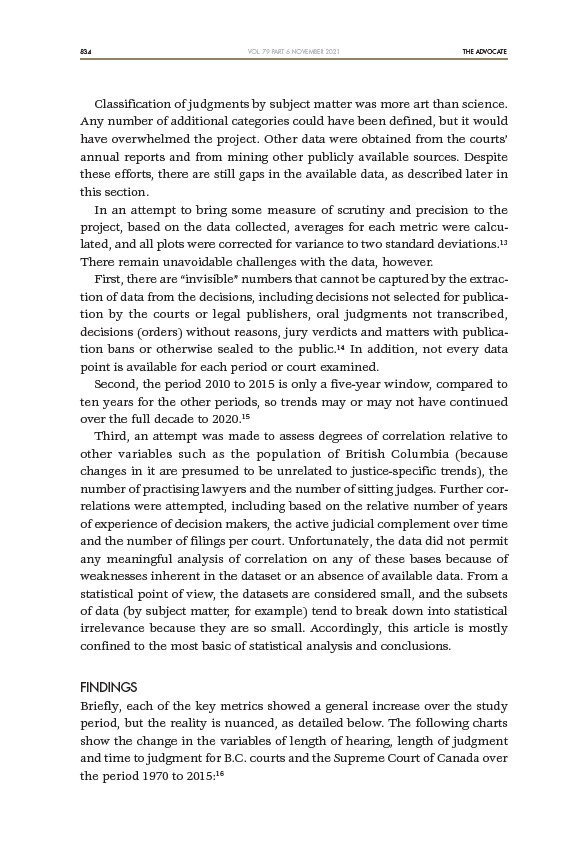
834 THE ADVOCATE
VOL. 79 PART 6 NOVEMBER 2021
Classification of judgments by subject matter was more art than science.
Any number of additional categories could have been defined, but it would
have overwhelmed the project. Other data were obtained from the courts’
annual reports and from mining other publicly available sources. Despite
these efforts, there are still gaps in the available data, as described later in
this section.
In an attempt to bring some measure of scrutiny and precision to the
project, based on the data collected, averages for each metric were calculated,
and all plots were corrected for variance to two standard deviations.13
There remain unavoidable challenges with the data, however.
First, there are “invisible” numbers that cannot be captured by the extraction
of data from the decisions, including decisions not selected for publication
by the courts or legal publishers, oral judgments not transcribed,
decisions (orders) without reasons, jury verdicts and matters with publication
bans or otherwise sealed to the public.14 In addition, not every data
point is available for each period or court examined.
Second, the period 2010 to 2015 is only a five-year window, compared to
ten years for the other periods, so trends may or may not have continued
over the full decade to 2020.15
Third, an attempt was made to assess degrees of correlation relative to
other variables such as the population of British Columbia (because
changes in it are presumed to be unrelated to justice-specific trends), the
number of practising lawyers and the number of sitting judges. Further correlations
were attempted, including based on the relative number of years
of experience of decision makers, the active judicial complement over time
and the number of filings per court. Unfortunately, the data did not permit
any meaningful analysis of correlation on any of these bases because of
weaknesses inherent in the dataset or an absence of available data. From a
statistical point of view, the datasets are considered small, and the subsets
of data (by subject matter, for example) tend to break down into statistical
irrelevance because they are so small. Accordingly, this article is mostly
confined to the most basic of statistical analysis and conclusions.
FINDINGS
Briefly, each of the key metrics showed a general increase over the study
period, but the reality is nuanced, as detailed below. The following charts
show the change in the variables of length of hearing, length of judgment
and time to judgment for B.C. courts and the Supreme Court of Canada over
the period 1970 to 2015:16